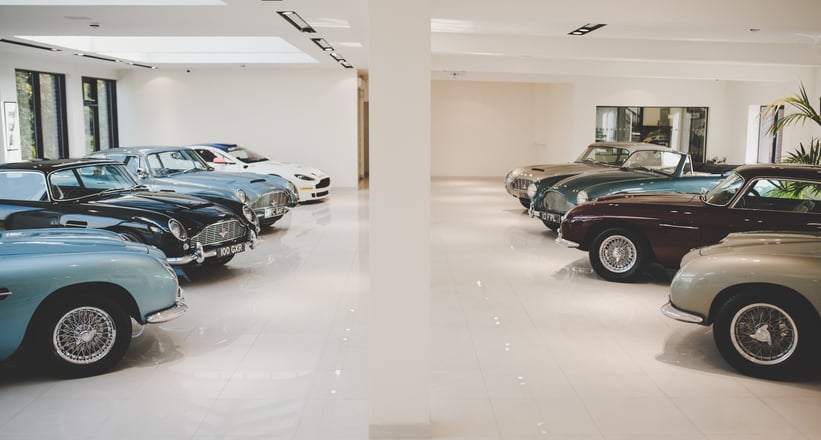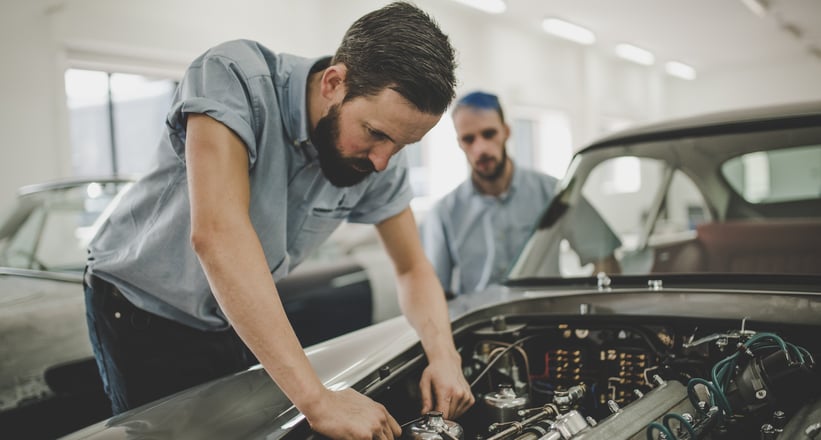The golden late-summer sunshine pours into Adrian Johnson’s spectacular first-floor showroom full of glistening old Aston Martins – a space as generous, minimal, and clean as the high-tech workshop downstairs, in which Astons of all eras are fastidiously restored to their former glories. Situated in the idyllic countryside close to the affluent town of Harrogate in the north of England, the company, which some will remember used to be called Post Vintage, was founded by Adrian Johnsons’ father Chris in 1979 as a way of helping out his friends in the Aston Martin Owners’ Club. Though Chris has since relinquished the reigns to his son, he can still be found tinkering in his dedicated engine workshop most days of the week.



While both classic and modern-era Astons are sourced, sold and maintained at Adrian Johnson, it’s the concours-winning restorations of the iconic DB series of cars for which the business has become best known. A small team of highly skilled craftsmen, including Adrian himself, undertake everything from steel fabrication, chassis repairs, and engine rebuilds to paintwork, trimming, and electricals, all in-house. As someone who grew up surrounded by these cars and has since dedicated his life to preserving their condition and values, Johnson is more qualified than most to comment on their appeal, position in today’s collector-car market, and future, which, as you’ll read, is potentially threatened from the very same company that brought them to fruition.



What are your earliest automotive memories?
My father’s always been into his cars and I grew up with a lot of pre-War MGs and the like. He bought an Aston Martin DB2/4, which became our daily driver – we went everywhere in that car. At the time, I hated it because everyone else had a Ford Cortina and we were the odd ones out. I raced that Aston for years and we kept it until the 1990s.
Could you tell us about the early days of the business and how you became involved?
My father Chris started the business in 1979, initially just doing restoration and servicing works for his friends in the Aston Martin Owners’ Club. I was still at school at the time, but by the time I was 13, I was going in to help out on the weekends. Dad was less motivated as a businessman and more interested in fixing cars. I, on the other hand, liked to buy and sell cars because that’s where you could make some decent money and experience different cars.



You’re also a skilled metalworker and enjoy getting your hands dirty in the workshop – what is your favourite aspect of the business today?
I got into the metalwork when more and more cars needed new panels. Dad couldn’t teach me how to do it because he didn’t know how, so it was a case of buying a machine and having a go. I’m quite determined and eventually worked out how to do it – once you pick up such a skill, you never lose it. I like all aspects of the business, however. Every single car is different, which means you can’t automate the process. For me, it’s all about doing things correctly and having a small number of people in the workshop allows us to control the quality.
What is the appeal of Aston Martin for you?
It’s really the fact I grew up around the cars – we all have things from our childhoods that we connect with and revisit. Today, concours events and the Aston Martin Owners’ Club are so precious, but I remember the early days when Nick Mason’s children would get told off for climbing on the cars. I also love the way Astons are constructed. People often say they weren’t that good, but they really were – it’s evident that they were handmade, and the craftsmanship was amazing.



The business has recently undergone a rebrand, including a name change from Post Vintage to Adrian Johnson – what were the reasons for this?
At the time Post Vintage was started, the name was right because the business catered to cars from the post-vintage era. But as time progressed, most people in their thirties and forties didn’t understand the name. Plus, I know virtually everyone in the Aston world and they never associated the old name with me.
And could you summarise the philosophy of the business today?
We’ve developed from an old company with old-fashioned values in an old building into a modern company in a high-tech and clean space, still with the knowledge and expertise needed to look after the condition and values of these cars. In that respect, we’re constantly looking for new people on which to pass on the knowledge and skills. But surprisingly, there’s a lack of people who want to get into the profession.



Why do you feel there is a clear north-south divide in the British Aston Martin world?
Traditionally, Aston Martin specialists have been near or south of Newport-Pagnell. In the late-1980s, we had to travel down the country if we wanted to buy a car. And even now, people just don’t seem to want to go north. I think nothing of driving for four hours to the Goodwood Revival, and people shouldn’t think anything of coming up here when the north has so much to offer – people just don’t realise that and I can’t put my finger on why.
How do you think the Aston Martin market has changed in recent years, particularly with regards to restoration?
Traditionally, we’ve bought barn finds to restore from places such as Bonhams’ Aston Martin sale. But in the last few years, we’ve seen so few of them around. We’re certainly not seeing any old DB4s, DB5s, and DB6s coming to market anymore and I don’t think anyone’s finding them. It’s also difficult because restoration has become so expensive and the number of unrepeatable parts is rising every day. In building the continuation DB4s, Aston Martin itself has had loads of new parts made. But it won’t supply them to outside specialists. Original and new parts are being produced for the replica ‘new’ cars but not for the real old ones, which is worrying!

What do you drive at the weekend?
Well, I’m having an original Cobra restored and I love my Aston Martin DB5, which is completely original and I’ve owned for years and years.
Photos: Jack Passey for Classic Driver © 2018









































